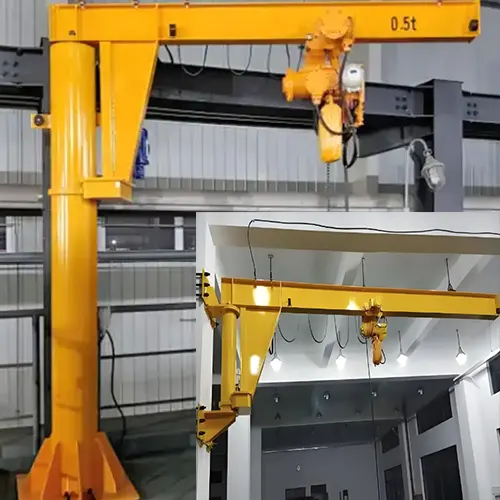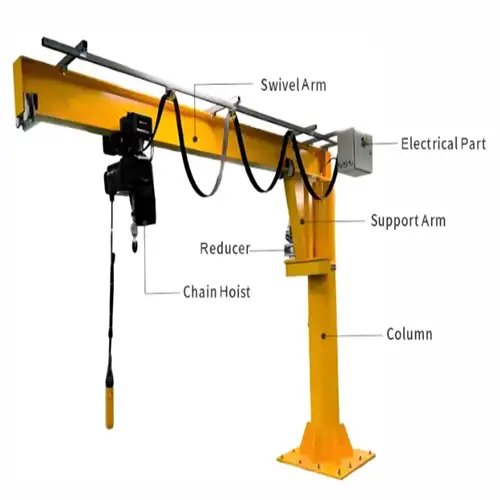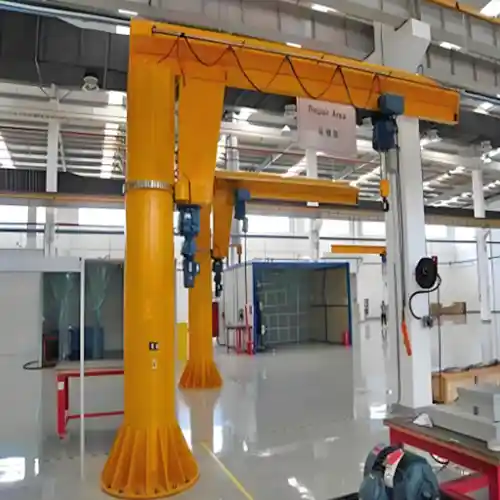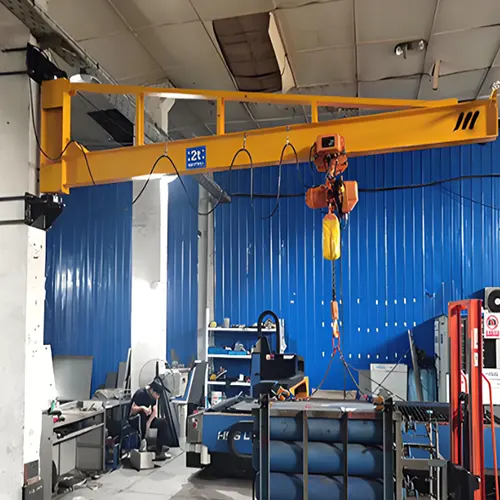Cantilever Crane for Sale: Wall Cantilever Cranes & Floor Cantilever Cranes
Cantilever cranes for sale include wall and floor models, offering versatile, space-efficient solutions for various industrial lifting needs.
Category: Jib Crane
Your Trusted Cantilever Jib Crane Manufacturer & Supplier
Cantilever Crane for Sale: Wall Cantilever Cranes & Floor Cantilever Cranes
Cantilever cranes for sale include wall and floor models, offering versatile, space-efficient solutions for various industrial lifting needs.
Cantilever cranes are a type of crane with a unique structure that allows them to extend their reach without needing support from the ground beneath the crane's main body. They consist of a horizontal arm or jib that extends outward from a vertical support, providing the ability to lift and move loads over a specific area. There are two main types: wall cantilever cranes, which are mounted on a wall or building structure, and floor cantilever cranes, which are supported by a base on the floor. This design enables cantilever cranes to operate effectively in areas where space is limited or where traditional cranes might be impractical.
Importance and Versatility in Various Industrial Applications
Cantilever cranes are highly valued for their flexibility and efficiency in a range of industrial settings. Their design allows them to be used in tight spaces where other cranes might not fit, making them ideal for workshops, warehouses, and production lines.
In manufacturing environments, wall cantilever cranes are often used to handle heavy components or equipment close to the production area, improving workflow and reducing the need for manual handling. Floor cantilever cranes, on the other hand, are beneficial in areas with ample floor space, such as assembly lines or large storage areas, where they can cover a wide working radius.
Additionally, cantilever cranes are versatile in handling various materials and products, from small components to larger, bulkier items. Their ability to reach over obstacles and extend beyond their base makes them particularly useful for tasks like loading and unloading, maintenance operations, and assembly processes. This adaptability not only enhances productivity but also contributes to safer and more efficient operations across different industrial sectors.
Wall Cantilever Cranes
Wall cantilever cranes are versatile lifting solutions designed to be mounted directly onto walls or structural supports. These cranes are ideal for operations where floor space is limited, as they extend outward from a wall, optimizing vertical space and providing efficient material handling capabilities. Wall cantilever cranes can be used for a variety of tasks, including moving and positioning heavy loads in manufacturing, maintenance, and warehousing environments. Their design allows for precise and accessible lifting while minimizing floor clutter and maximizing workspace efficiency.
Types of Wall Cantilever Cranes
Wall cantilever cranes come in various types, each designed to suit different operational needs and environments. Here are the primary types:
- Wall-Mounted Cantilever Cranes: These cranes are fixed to a wall or vertical structure, extending outward to lift and transport materials. Their design is ideal for environments with limited floor space, as they utilize wall space to provide effective lifting capabilities while keeping the floor area clear.
- Wall-Travelling Cantilever Cranes: These cranes are mounted on rails or tracks attached to the wall, allowing them to travel horizontally along the wall's length. This type of crane offers increased flexibility by covering a larger area and reaching multiple workstations along the wall, making it suitable for extensive manufacturing or warehousing operations.
Each type of wall cantilever crane offers distinct advantages, such as space-saving designs for wall-mounted cranes and expanded operational range for wall-travelling cranes, enabling them to meet diverse material handling needs effectively.

A wall-mounted cantilever crane is anchored directly to a building's wall or structural column. It features a horizontal arm or jib that extends outward from the wall, allowing it to handle loads in an area that would otherwise be difficult to access. The crane's design typically includes a vertical support bracket or column fixed to the wall, from which the jib extends.
These cranes are often equipped with a manual or electric hoist for lifting and lowering loads. The arm can usually rotate around its axis, providing a wide range of motion. Some models may also offer adjustable jibs to accommodate different load handling requirements.
Typical Applications
Wall-mounted cantilever cranes are commonly used in environments where floor space is limited or where the ceiling height is insufficient for traditional cranes. They are ideal for:
- Workshops and Small Manufacturing Facilities: Where space constraints require lifting equipment to be mounted against walls rather than occupying valuable floor area.
- Maintenance and Repair Shops: For handling machinery or components close to the work area without obstructing walkways.
- Warehouses and Storage Areas: To reach and move items stored near walls or in tight aisles.
Advantages and Limitations
Advantages:
- Space Efficiency: By mounting the crane on a wall, valuable floor space remains clear, making it ideal for confined areas.
- Increased Accessibility: The crane's ability to extend and rotate provides easy access to areas that are difficult to reach with other types of cranes.
- Cost-Effective: Generally more affordable than floor-mounted cranes due to reduced material and installation costs.
Limitations:
- Load Capacity Constraints: The capacity of a wall-mounted cantilever crane is often limited by the wall's strength and the crane's design. Heavy loads might require more robust structural support.
- Installation Requirements: Requires a suitable wall or structural column capable of supporting the crane's load and operational stresses.
- Limited Reach: The crane's reach is restricted by the length of the jib and the wall's dimensions, which can limit its utility in larger areas.

Wall Travelling Cantilever Cranes
A wall travelling cantilever crane combines the functionality of a wall-mounted cantilever crane with the added capability of horizontal movement along a wall or track. This design features a horizontal beam or jib that extends from a vertical support mounted on a wall or column. Unlike fixed wall-mounted cranes, the wall travelling version is mounted on a track or rail system attached to the wall, allowing the crane to travel horizontally along this track.
Key design features include:
- Track System: The crane operates on a rail or track system attached to the wall, enabling it to move along the wall's length.
- Jib and Hoist: The crane's jib extends outward from the wall, and it is equipped with a hoist for lifting and lowering loads. The jib can often rotate to provide a wide range of motion.
- Movement Mechanism: Typically, the crane includes a motorized system for moving along the track, although some models may use manual controls.
Typical Applications
Wall travelling cantilever cranes are used in various scenarios where the benefits of wall-mounted cranes are enhanced by the ability to move horizontally:
- Large Workshops and Manufacturing Facilities: Where the ability to move loads across the length of the workshop improves efficiency in moving materials and equipment.
- Maintenance and Assembly Areas: For handling and positioning parts along long production or maintenance lines.
- Storage and Retrieval Systems: In warehouses and distribution centers where items need to be moved along long shelves or storage areas.
Advantages and Limitations
Advantages:
- Enhanced Mobility: The ability to travel horizontally along the wall extends the crane's reach across a larger area, improving access and flexibility within the workspace.
- Space Optimization: Like fixed wall-mounted cranes, wall travelling cranes conserve floor space while offering increased operational range.
- Increased Efficiency: Facilitates quicker and easier handling of materials over extended areas, reducing the need for multiple cranes or manual handling.
Limitations:
- Track Installation: Requires a suitable wall structure and a track system, which can involve additional installation and maintenance costs.
- Load Capacity Constraints: The crane's load capacity can be limited by the wall's structural strength and the design of the track system. Heavier loads may require additional support.
- Limited Vertical Reach: The crane's vertical movement is limited to the length of the jib and the height of the wall, which may restrict its use in environments with significant height requirements.
Floor Cantilever Cranes
Floor cantilever cranes are robust lifting solutions mounted directly on the floor, designed to handle a wide range of material handling tasks. These cranes come in two main types: floor-mounted and floor-travelling portable. Floor-mounted cranes offer stability and high lifting capacity, making them ideal for heavy-duty operations in manufacturing and warehouse settings. Floor-travelling portable cranes, on the other hand, provide mobility and flexibility, allowing for easy repositioning across different areas within a facility. Both types enhance operational efficiency by optimizing space and improving accessibility for various lifting tasks.
Type of Floor Cantilever Cranes
Floor cantilever cranes are designed to be mounted directly on the floor, providing versatile lifting solutions in various industrial and commercial settings. The main types are:
- Floor-Mounted Cantilever Cranes: These cranes are fixed to a base or pedestal on the floor, allowing them to lift and move materials across a defined area. They are suitable for operations requiring substantial lifting capacity and stability, making them ideal for heavy-duty tasks in manufacturing and warehouse environments.
- Floor-Travelling Portable Cantilever Cranes: These cranes are mounted on wheels or casters, enabling them to move freely across the floor. Their portability allows for flexible use in different locations within a facility, making them useful for tasks that require mobility and adaptability, such as in assembly lines or maintenance areas.
Each type of floor cantilever crane provides specific benefits, with floor-mounted cranes offering stability and high capacity, while floor-travelling portable cranes offer mobility and adaptability to various tasks and locations.
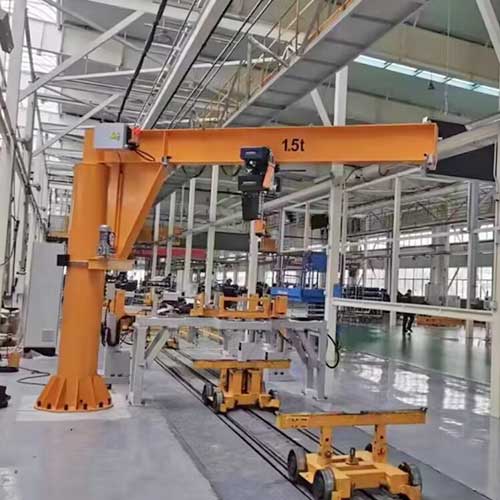
Floor-Mounted Cantilever Cranes
Floor-mounted cantilever cranes are designed to be supported by a base mounted on the floor. Unlike wall-mounted versions, these cranes do not rely on structural walls for support but instead use a robust base to provide stability and strength.
Key design features include:
- Base and Column: The crane is supported by a heavy-duty base and vertical column, which provide the necessary stability and strength for lifting and moving loads.
- Horizontal Arm (Jib): The horizontal arm extends outward from the column and is used to lift and transport loads. This arm can often be adjusted or rotated to accommodate different operational needs.
- Hoist and Control Systems: Equipped with a hoist for lifting and lowering materials, and typically includes manual or electric controls for operating the crane.
Typical Applications
Floor-mounted cantilever cranes are versatile and used in various settings where a stable and flexible lifting solution is required:
- Manufacturing Plants: Ideal for lifting and moving heavy components and materials within production areas. They are especially useful in assembly lines where access across the floor is needed.
- Warehouses: Used for loading and unloading materials from shelves or storage areas, providing easy access and efficient handling.
- Workshops and Maintenance Areas: Suitable for handling tools, parts, and equipment in workshops or repair facilities where floor space is available.
Advantages and Limitations
Advantages:
- Flexibility: Provides a wide range of motion with the ability to cover a large working area, making it suitable for various lifting and handling tasks.
- Stability and Strength: The robust base and column design offer strong support, allowing the crane to handle heavier loads compared to some wall-mounted options.
- Versatile Applications: Can be used in various industrial environments, from manufacturing to warehousing, due to its adaptability and range of motion.
Limitations:
- Space Requirements: Requires sufficient floor space for the base and column, which may not be suitable for environments with limited space.
- Installation Complexity: Installation involves setting up a solid base and ensuring that the crane is securely anchored, which can be more complex compared to wall-mounted cranes.
- Cost Considerations: Generally more expensive due to the need for a sturdy base and additional installation work. Long-term maintenance and operational costs can also be higher.
This type of crane is designed to maximize efficiency and accessibility in areas where wall mounting is not feasible or where extensive floor coverage is beneficial.
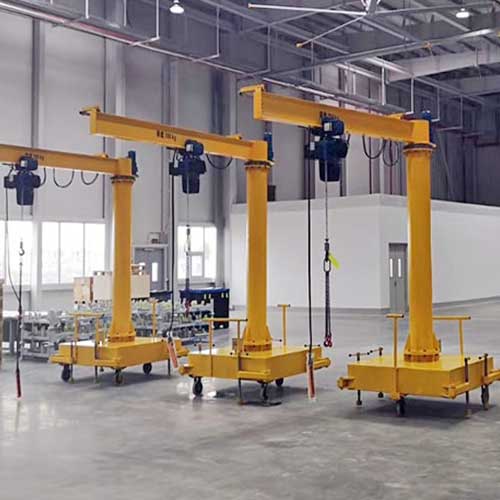
Portable Jib Crane with Cantilever Design
Floor travelling portable cantilever cranes combine the capabilities of a cantilever crane with the flexibility of portability and movement along the floor. These cranes are designed to be easily moved and repositioned within a workspace, providing versatile lifting solutions for various applications.
Key design features include:
- Mobile Base: Equipped with wheels or casters, allowing the crane to be easily moved across the floor. The base is often designed to be stable and robust, ensuring safe operation during movement.
- Column and Jib: The crane features a vertical column that supports a horizontal arm or jib. The jib extends outward and can be adjusted for different reach and lifting needs.
- Track System (Optional): Some models may include a track system or rail mounted on the floor, providing controlled movement along a defined path.
- Hoist and Controls: Includes a hoist for lifting and lowering loads, with controls for maneuvering the crane and operating the hoist.
Typical Applications
Floor travelling portable cantilever cranes are highly versatile and are used in a range of settings where mobility and flexibility are important:
- Workshops and Assembly Lines: Ideal for moving tools, parts, and equipment within a workshop or assembly line, allowing for efficient handling and positioning.
- Maintenance and Repair Facilities: Used to move heavy or bulky items around repair or maintenance areas, facilitating easy access and reducing manual handling.
- Warehouses and Storage Areas: Useful for relocating materials and products within storage areas, particularly when the layout or inventory changes frequently.
Advantages and Limitations
Advantages:
- Portability: The ability to move the crane easily from one location to another enhances flexibility and allows for dynamic use across different areas of a facility.
- Versatile Operation: Provides a wide range of motion and can be repositioned to handle various tasks, making it suitable for multiple applications within the same workspace.
- Space Efficiency: While mobile, the crane can be used in tight spaces where a fixed crane might not fit, and it can be moved out of the way when not in use.
Limitations:
- Load Capacity: The load capacity may be limited by the design of the mobile base and the stability of the crane during movement. Heavier loads might require additional support or a more robust system.
- Floor Surface Requirements: Requires a suitable floor surface to ensure stable movement. Uneven or unsuitable flooring can affect the crane's operation and stability.
- Cost and Maintenance: Portable cranes can be more expensive due to their mobility features, and ongoing maintenance may be required to ensure smooth operation and durability of the moving parts.
Floor travelling portable cantilever cranes are ideal for environments where mobility and flexibility are crucial, offering an effective solution for various lifting and handling tasks across a wide range of applications.
Hot Sale Capacity of Each Type of Cantilever Crane
Wall Cantilever Cranes

Wall-Mounted Crane:
- Small Capacity: 0.5 tons to 2 tons. These cranes are ideal for light-duty tasks in confined spaces, such as handling small components or tools.
- Medium Capacity: 2 tons to 5 tons. Suitable for medium-duty applications, these cranes handle heavier materials and are commonly used in small to medium-sized workshops and maintenance areas.

Wall Travelling Cantilever Crane:
- Small Capacity: 0.5 tons to 1 ton. These cranes are designed for light to medium-duty tasks where the crane needs to move along a track mounted on the wall.
- Medium Capacity: 1 ton to 3 tons. Provides additional flexibility for handling heavier materials while travelling along the wall, making them suitable for larger workshops and storage areas.
Floor Cantilever Cranes

Floor-Mounted Cantilever Crane:
- Small Capacity: 0.5 tons to 3 tons. These cranes are used for light to medium-duty applications in various settings such as workshops and assembly lines.
- Medium Capacity: 3 tons to 16 tons. Suitable for handling heavier materials in larger manufacturing plants or warehouses, providing robust support for significant lifting tasks.

Floor Travelling Portable Cantilever Crane:
- Small Capacity: 0.25 tons to 1 ton. Ideal for light-duty tasks where portability and maneuverability are key, used in smaller workspaces or for handling lighter loads.
- Medium Capacity: 1 ton to 2 tons. Provides enhanced mobility and flexibility for handling moderately heavy materials, making it suitable for various industrial and maintenance applications.
How Capacity Affects Crane Selection
Operational Needs
The required load capacity of a crane is determined by the types and weights of materials or components it needs to handle.
- Material Type and Weight: For lifting and transporting heavier or bulkier items, such as large machinery or heavy industrial components, a crane with a higher load capacity is essential. This ensures that the crane can safely lift and move these materials without excessive strain. Conversely, for lighter items, such as small components or tools, a crane with a lower capacity will suffice, reducing costs and potentially optimizing the crane's performance for less demanding tasks.
- Frequency and Volume of Use: If the crane will be used frequently or in high-volume operations, selecting a crane with a higher capacity than the typical load can provide additional safety margins and accommodate variations in load sizes. This helps in maintaining operational continuity and reducing the risk of overloading during peak times.
Safety Considerations
Selecting the appropriate crane capacity is crucial for ensuring safe operation and preventing hazards associated with overloading.
- Preventing Overloading: A crane that is not adequately rated for the load being handled risks mechanical failure or structural damage. Overloading can cause the crane to malfunction, potentially leading to accidents, injuries, or damage to the load and surrounding equipment. Ensuring that the crane's capacity exceeds the maximum expected load by a reasonable margin enhances safety and operational reliability.
- Structural Integrity: Cranes are designed with specific load ratings based on their construction and materials. Choosing a crane with the correct capacity ensures that all components, including the hoist, jib, and support structure, operate within their designed limits, maintaining structural integrity and longevity.
Efficiency and Productivity
Proper crane capacity selection directly impacts operational efficiency and productivity.
- Optimized Performance: A crane with the right capacity for the task will operate more smoothly and efficiently, handling loads within its designed limits without unnecessary strain. This minimizes the risk of breakdowns and maintenance issues, ensuring consistent performance and reducing downtime.
- Operational Flexibility: Selecting a crane with slightly higher capacity than needed can provide additional flexibility for handling unexpected loads or variations in material size. This can prevent delays and increase productivity by allowing the crane to handle a wider range of tasks without requiring frequent adjustments or equipment changes.
- Cost Efficiency: While higher capacity cranes may have a higher initial cost, they can offer long-term savings by reducing the need for multiple cranes or additional equipment. Proper capacity selection also helps avoid overloading and the associated costs of repairs or replacements due to equipment failure.
In summary, carefully considering crane capacity is essential for meeting operational needs, ensuring safety, and optimizing efficiency. By selecting a crane with an appropriate load capacity, businesses can enhance productivity, reduce risks, and achieve a more reliable and effective lifting solution.
Custom Capacity Solutions
Options for Custom Capacities
Custom Jib Lengths and Designs:
- Extended Jib Lengths: For handling larger or unusually shaped loads, cranes can be customized with extended jib lengths. This allows the crane to reach further into areas that are not accessible with standard jib lengths, making it suitable for specialized tasks such as lifting oversized components or accessing hard-to-reach locations.
- Custom Jib Designs: Tailoring the design of the jib can address specific operational needs. This might include modifications such as angled jibs for better clearance or reinforced jibs for handling heavier loads. Custom designs ensure that the crane can accommodate particular load shapes or movement patterns effectively.
Enhanced Hoist Systems:
- High-Capacity Hoists: Upgrading to a high-capacity hoist system increases the crane's lifting power, enabling it to handle heavier loads safely. High-capacity hoists are designed to operate efficiently under increased loads while maintaining smooth and reliable performance.
- Additional Hoisting Equipment: Adding supplementary hoisting equipment, such as dual hoists or a multi-fall arrangement, can enhance the crane's lifting capacity and versatility. This setup allows for greater load distribution and improved handling of very heavy or bulky items.
Reinforced Structures:
- Reinforced Base and Columns: Custom solutions often involve strengthening the crane's support structures. Reinforced bases or columns ensure that the crane can safely handle higher loads without compromising stability or safety. This may include using more robust materials or additional structural supports.
- Upgraded Materials: Using high-strength materials for critical components, such as the support columns and base, can increase the crane's load-bearing capacity. These materials are designed to withstand greater stresses and provide long-term durability under heavy load conditions.
Considerations for Custom Capacity Solutions
- Load Characteristics: When customizing a crane, it's crucial to understand the specific characteristics of the loads being handled, including weight, size, and shape. This information helps in designing a crane that meets the exact requirements of the operation.
- Operating Environment: Custom solutions should account for the operating environment, including factors such as temperature extremes, corrosive conditions, or space constraints. Ensuring that the crane's design and materials are suitable for these conditions is essential for maintaining performance and safety.
- Regulatory Compliance: Any custom modifications must adhere to industry standards and safety regulations. This includes ensuring that the crane's custom features are tested and certified to meet safety and performance requirements.
Custom capacity solutions enable businesses to tailor cranes to their specific needs, ensuring optimal performance and safety for specialized lifting tasks. By addressing unique load handling requirements and operating conditions, custom solutions provide a flexible and efficient approach to material handling challenges.
Considerations for Special Load Requirements
- Load Type and Distribution: Consider the nature of the load, such as whether it is a single heavy item or multiple smaller items. Special provisions may be needed for uneven or distributed loads.
- Environmental Factors: Take into account the operating environment, including temperature extremes, corrosive conditions, or hazardous environments, which may impact the crane's design and capacity requirements.
- Regulatory Compliance: Ensure that custom solutions meet all relevant safety and industry standards. This includes adhering to load capacity regulations and ensuring that all modifications are tested and certified.
Custom capacity solutions allow for the flexibility to meet specific operational needs and handle a diverse range of lifting tasks, enhancing the overall efficiency and functionality of cantilever cranes in various industrial settings.
Applications of Cantilever Cranes
Industrial Applications
Manufacturing and Assembly Lines:
- Material Handling: Cantilever cranes are widely used in manufacturing and assembly lines to transport raw materials, components, and finished products. Their design allows for efficient movement of materials across workstations and assembly areas, improving workflow and productivity.
- Precision Lifting: In assembly lines, cantilever cranes can be used to handle delicate or precise components, ensuring that parts are moved without damage. Their flexibility in positioning allows for accurate placement of components during assembly.
- Space Efficiency: Cantilever cranes, especially wall-mounted or floor-mounted types, help maximize floor space by utilizing vertical space and minimizing the need for extensive floor tracks or rail systems.
Maintenance and Repair Tasks:
- Equipment Support: In maintenance shops, cantilever cranes assist in lifting and positioning heavy equipment or machinery for repair and servicing. Their ability to reach over and around obstacles makes them ideal for accessing hard-to-reach areas.
- Tool and Part Handling: They also facilitate the handling of tools and spare parts, making it easier to organize and access necessary items during maintenance procedures.
Commercial and Retail Uses
Stockroom and Warehouse Operations:
- Efficient Storage: Cantilever cranes are employed in stockrooms and warehouses to streamline the storage and retrieval of goods. They allow for the efficient movement of items to and from shelves, optimizing storage space and reducing manual handling.
- High-Density Storage: In warehouses with high-density storage solutions, cantilever cranes can reach into high racks or narrow aisles, facilitating the handling of goods without the need for extensive floor space.
Display and Handling of Goods:
- Retail Displays: In commercial settings, cantilever cranes can be used to display large or heavy items in retail environments, such as furniture stores or equipment showrooms. Their adjustable arms and precise positioning capabilities enhance the presentation and accessibility of products.
- Product Handling: They assist in managing stock levels and reorganizing displays, enabling efficient reconfiguration of product layouts to accommodate changing inventory needs or promotional displays.
Specialized Applications
Handling of Unusual or Heavy Items:
- Custom Lifting Solutions: Cantilever cranes are customized to handle unusual or exceptionally heavy items, such as oversized machinery, large components, or specialized equipment. Custom attachments or modifications ensure safe and effective lifting of these challenging loads.
- Unique Load Shapes: They are also used to manage irregularly shaped or awkwardly sized items that require specialized lifting and positioning solutions.
Custom Solutions for Unique Environments:
- Extreme Conditions: In environments with specific conditions such as high temperatures, corrosive substances, or hazardous materials, cantilever cranes can be adapted with specialized coatings, materials, or safety features to meet these challenges.
- Space Constraints: For facilities with limited space or unique layout requirements, custom cantilever cranes can be designed to fit within these constraints while still providing the necessary lifting capabilities and functionality.
By adapting cantilever cranes to various applications and environments, businesses can enhance their operational efficiency and effectively address specific material handling challenges across industrial, commercial, and specialized settings.
Factors to Consider When Buying
Space and Layout
Space Requirements for Wall and Floor-Mounted Cranes:
- Wall-Mounted Cranes: These cranes are installed along walls, making efficient use of vertical space. Ensure that there is sufficient clearance from the wall and overhead obstacles for the crane's full range of motion. Wall-mounted cranes are ideal for areas with limited floor space but require adequate wall structure to support the load.
- Floor-Mounted Cranes: Floor-mounted cranes require sufficient floor area for their base and support structure. Consider the footprint of the crane, including its base dimensions and any additional space needed for movement. Ensure that the crane's position allows for unobstructed operation and integrates well with existing equipment and workflows.
Impact on Facility Layout and Workflow:
- Workflow Optimization: The placement of cranes should enhance the efficiency of material handling processes. Assess how the crane's location will affect the movement of goods and personnel within the facility. Proper positioning can reduce travel time, minimize congestion, and streamline operations.
- Facility Layout: Incorporate the crane into the overall facility layout plan, considering factors such as accessibility, safety zones, and integration with other equipment. Ensure that the crane's installation does not interfere with existing processes or obstruct essential pathways.
Load Handling and Safety
Ensuring Proper Load Handling Capacity:
- Capacity Matching: Select a crane with a load capacity that meets or exceeds the maximum weight of the items to be handled. Consider both the typical and peak load requirements to ensure the crane can handle all expected loads without strain.
- Load Distribution: Ensure that the crane can handle the specific load distribution requirements, including single heavy items or multiple smaller items. Custom solutions might be needed for handling unusual or uneven loads effectively.
Safety Features and Compliance with Regulations:
- Safety Mechanisms: Look for cranes equipped with essential safety features, such as overload protection, emergency stop buttons, and safety interlocks. These features help prevent accidents and ensure safe operation under various conditions.
- Regulatory Compliance: Verify that the crane meets all relevant safety and industry standards, such as those set by OSHA or other regulatory bodies. Ensure that the crane is certified for its intended use and that any custom modifications are tested and compliant with regulations.
Cost and Budget
Pricing Factors for Different Types and Capacities:
- Initial Cost: The price of a crane varies based on its type (e.g., wall-mounted vs. floor-mounted), load capacity, and customization features. Compare costs across different models and configurations to find one that fits your budget while meeting your needs.
- Custom Features: Customizations such as extended jibs, enhanced hoists, or reinforced structures can increase the initial cost. Factor these additional expenses into your budget if specialized features are required.
Long-Term Cost Considerations, Including Maintenance:
- Maintenance Costs: Consider the ongoing maintenance and repair costs associated with the crane. Regular maintenance is essential for ensuring reliable operation and extending the crane's lifespan. Factor in costs for routine inspections, parts replacement, and any necessary repairs.
- Operational Costs: Evaluate the potential operational costs, including energy consumption, downtime, and any additional training required for personnel. Choose a crane that balances initial costs with long-term operational efficiency to optimize your overall investment.
By carefully evaluating these factors, you can make an informed decision when purchasing a cantilever crane, ensuring that it meets your facility's requirements, enhances safety, and provides value over the long term.
Conclusion: Customized Cantilever Crane for Your Needs
In selecting the right cantilever crane, several critical factors must be considered to ensure the equipment meets the specific needs of your operation:
- Types of Cantilever Cranes: Wall-mounted and floor-mounted cantilever cranes each offer unique advantages and are suited for different applications. Wall-mounted cranes save floor space and are ideal for environments with limited area, while floor-mounted cranes provide robust support and are versatile for various lifting tasks.
- Capacity Requirements: Proper capacity selection is crucial for efficient and safe operation. Custom solutions may be needed to handle unusual or heavy loads, and the crane's design should align with the specific load requirements of your facility.
- Applications: Cantilever cranes are versatile and can be used in industrial manufacturing, commercial and retail settings, and specialized environments. Each application requires careful consideration of the crane's capabilities and features.
- Factors to Consider: Space and layout impact the crane's integration into your facility, while load handling and safety features ensure the crane performs reliably and safely. Cost considerations include both initial purchase and long-term maintenance expenses.
Final Recommendations for Selecting the Right Cantilever Crane
- Assess Your Needs: Begin by thoroughly evaluating your operational requirements, including the types of loads to be handled, the operating environment, and available space. This assessment will guide your choice between wall-mounted and floor-mounted cranes and help determine the necessary capacity.
- Prioritize Safety: Ensure that the crane you select includes essential safety features and complies with relevant regulations. Investing in a crane with robust safety mechanisms and certifications will protect both your equipment and personnel.
- Consider Custom Solutions: If your operations involve unique load handling requirements or specialized environments, consider custom capacity solutions. Tailoring the crane to your specific needs can enhance performance and efficiency.
- Evaluate Costs: Compare pricing for different crane types and capacities, and factor in both initial costs and long-term maintenance. Choose a crane that offers a good balance between upfront investment and ongoing operational costs.
- Plan for Integration: Consider how the crane will fit into your existing facility layout and workflow. Proper integration will optimize efficiency and minimize disruption to your operations.
By addressing these key considerations, you can make an informed decision and select a cantilever crane that enhances your material handling capabilities, improves safety, and delivers long-term value for your operations.
Main Projects
Related Products

Supplied three grab bucket crane kits to Indonesia, enhancing garbage handling efficiency with high load capacity and reliable performance.
Free consultation to Confirm Parameters & Specifications and Get
Latest Crane Price & Crane Rate.
- Types of overhead cranes : _______?
- Optional: Overhead travelling crane, goliath gantry crane,Slewing jib crane, Single girder or double girder crane,small portable crane or kbk crane, etc.
- Capacity of overhead crane: _______?
- Optional: 0.25ton, 0.5 ton, 1 ton, 2 ton, 3ton, 5 ton, 10 ton,15ton, 20ton, 25 ton, 30ton,35ton, up to 550ton, etc.
- Crane span & lifting height : _______?
- Crane travelling length : _____?
- Control of overhead crane:_______?
- Optional: pendant/ remote/cabin control
- Voltage supply of overhead crane:_____?
- Eg,: 380V50/60HZ,3Phase or others,etc.
- Application/usage of crane:_______?
- Eg,: Steel mill, ,injection mold, cement,stone, concrete,granite, general manufacturing, etc.
Just leave a message via the contact form and our hoist and crane engineer will contact you with in 24working hours.
Get In Touch
